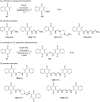Menadione: a platform and a target to valuable compounds synthesis
- PMID: 35529893
- PMCID: PMC9039524
- DOI: 10.3762/bjoc.18.43
Menadione: a platform and a target to valuable compounds synthesis
Abstract
Naphthoquinones are important natural or synthetic compounds belonging to the general class of quinones. Many compounds in this class have become drugs that are on the pharmaceutical market for the treatment of various diseases. A special naphthoquinone derivative is menadione, a synthetic naphthoquinone belonging to the vitamin K group. This compound can be synthesized by different methods and it has a broad range of biological and synthetic applications, which will be highlighted in this review.
Keywords: 2-methyl-1,4-naphthoquinone; cancer; chemical reactions; quinone; synthetic platform; vitamin K.
Copyright © 2022, de Souza et al.
Figures



























































Similar articles
-
An Update on the Synthesis and Applications of Bis(Naphthoquinones): An Important Class of Molecules against Infectious Diseases and other Conditions.Curr Top Med Chem. 2021;21(22):1977-1998. doi: 10.2174/1568026621666210727165421. Curr Top Med Chem. 2021. PMID: 34315373 Review.
-
Formation of glutathione-conjugated semiquinones by the reaction of quinones with glutathione: an ESR study.Arch Biochem Biophys. 1987 Jan;252(1):41-8. doi: 10.1016/0003-9861(87)90006-3. Arch Biochem Biophys. 1987. PMID: 3028260
-
DT-diaphorase-catalysed reduction of 1,4-naphthoquinone derivatives and glutathionyl-quinone conjugates. Effect of substituents on autoxidation rates.Biochem J. 1989 Jan 15;257(2):561-71. doi: 10.1042/bj2570561. Biochem J. 1989. PMID: 2494985 Free PMC article.
-
In vivo exposure of Dreissena polymorpha mussels to the quinones menadione and lawsone: menadione is more toxic to mussels than lawsone.J Appl Toxicol. 2004 Mar-Apr;24(2):135-41. doi: 10.1002/jat.963. J Appl Toxicol. 2004. PMID: 15052609
-
Strategies for the Synthesis of Mono- and Bis-Thionaphthoquinones.Curr Org Synth. 2021 Oct 26;18(6):535-546. doi: 10.2174/1570179418666210224124603. Curr Org Synth. 2021. PMID: 33655837 Review.
Cited by
-
KuQuinones: a ten years tale of the new pentacyclic quinoid compound.RSC Adv. 2023 Mar 20;13(13):9065-9077. doi: 10.1039/d3ra00539a. eCollection 2023 Mar 14. RSC Adv. 2023. PMID: 36950082 Free PMC article. Review.
-
Synthesis of thia-Michael-Type Adducts between Naphthoquinones and N-Acetyl-L-Cysteine and Their Biological Activity.Molecules. 2022 Sep 1;27(17):5645. doi: 10.3390/molecules27175645. Molecules. 2022. PMID: 36080409 Free PMC article.
-
The protective effects of protocatechuic acid against natural and chemical toxicants: cellular and molecular mechanisms.Naunyn Schmiedebergs Arch Pharmacol. 2024 Aug;397(8):5597-5616. doi: 10.1007/s00210-024-03072-0. Epub 2024 Apr 12. Naunyn Schmiedebergs Arch Pharmacol. 2024. PMID: 38607443 Review.
-
Menadione Contribution to the In Vitro Radical Scavenging Potential of Phytochemicals Naringenin and Lignin.Int J Mol Sci. 2023 Nov 13;24(22):16268. doi: 10.3390/ijms242216268. Int J Mol Sci. 2023. PMID: 38003457 Free PMC article.
-
Vitamin A, D, E, and K as Matrix Metalloproteinase-2/9 Regulators That Affect Expression and Enzymatic Activity.Int J Mol Sci. 2023 Dec 1;24(23):17038. doi: 10.3390/ijms242317038. Int J Mol Sci. 2023. PMID: 38069361 Free PMC article. Review.
References
-
- de Carvalho da Silva F, Francisco Ferreira V. Curr Org Synth. 2016;13(3):334–371. doi: 10.2174/1570179412666150817220343. - DOI
-
- Goodwin T W, Mercer E I. Introduction to plant Biochemistry. Pergamon Press; 1972.
Publication types
LinkOut - more resources
Full Text Sources
